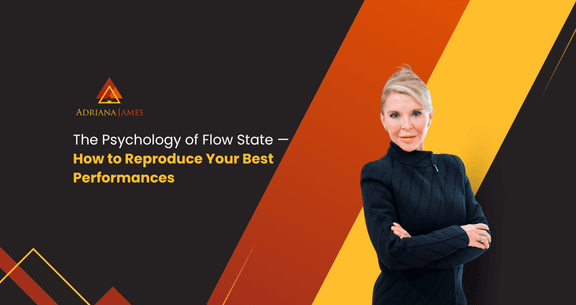The Myth of the Perfect Day
Ask any athlete, performer, or high-stakes professional about their best moment, and you’ll hear things like:
- “I didn’t have to think. It just flowed.”
- “Time slowed down.”
- “Everything clicked.”
That’s not magic. It’s a flow state.
And despite what most people think, flow isn’t random. It’s not luck. It’s not something that “happens to you” when the stars align.
Flow is a result of specific mental, emotional, and physical conditions converging at once.
The good news? You can recreate it.
In this article, you’ll learn:
- What a flow state actually is
- The three ingredients that trigger it
- How to decode your personal blueprint for flow
- And how to practice flow until it becomes repeatable
What Is Flow, Really?
Flow is a peak performance state where your skills match the challenge of the moment.
You’re fully immersed.
You’re not overthinking.
You’re not forcing.
You’re just doing, with full trust in your ability.
Psychologist Mihaly Csikszentmihalyi coined the term and identified it as the optimal state of consciousness where we feel and perform our best.
It applies to sports, music, business, even parenting.
But the question most people ask is: How do I get into flow on purpose?
Ingredient 1: Skill + Challenge = Activation
Flow doesn’t show up when things are too easy.
It also doesn’t show up when things are way over your head.
It appears when the challenge in front of you stretches your current skill level just enough to require your full attention.
Think of it like this:
- Too easy = boredom
- Too hard = anxiety
- Just right = flow
This is why coaching, feedback, and progressive challenges are critical.
When you’re consistently leveling up your skill, you give your brain new opportunities to enter flow.
Ask yourself:
- Am I bored in my training or too overwhelmed?
- How can I dial up the challenge to match my skill more closely?
Ingredient 2: Clear Goals and Immediate Feedback
Your brain loves clarity.
You can’t enter flow when your mind is distracted or confused.
Flow thrives when:
- You know exactly what you’re trying to accomplish
- You can see if you’re making progress (or not)
That means:
- Setting specific micro-goals for each session
- Creating real-time feedback loops (think: heart rate, form cues, timers, etc.)
- Removing distractions that pull focus
NLP teaches us this as the “chunking down” process. Take the big outcome and break it into small, actionable components.
The more clearly you define the task, the faster your mind locks in.
Ingredient 3: Internal Alignment (Mind + Emotion + Physiology)
This is where most people fall short. They think flow is just mental. But your entire state matters.
Flow happens when:
- Your mental intention is clear
- Your emotional state is calm, alert, and engaged
- Your body is energized but not tense
In other words, you’re integrated.
This is why tools like:
- Pre-performance routines
- Breath control
- State anchoring (from NLP)
- Visualization
…are so powerful. They help align your system so you’re not mentally ready but emotionally fried. Or physically ready but mentally scattered.
In The Leadership Edge, we guide athletes to identify their “best performance blueprint”— the internal recipe of thoughts, emotions, and physical sensations that were present during their top moments.
Once you know your blueprint, you can recreate it on command.
Practice Makes Flow
Flow doesn’t just happen because you want it to.
You have to train the conditions that make it possible.
Try this:
- Reflect on your best past performance.
- Write down everything you can remember about that moment:
- What were you thinking?
- How did you feel in your body?
- What was your emotional state?
- What did you focus on?
- Deconstruct it into a pattern.
- Start adding those elements into your training.
Repetition is key.
Eventually, your system will recognize the pattern and drop into flow faster and more reliably.
Don’t Chase Flow. Prepare for It.
The biggest mistake most people make? Chasing flow.
They try to force it. They obsess over it. They over-analyze it.
But flow isn’t something you chase. It’s something you prepare for.
The more you:
- Clarify your goals
- Match your challenges to your skill
- Align your internal state
…the more often flow will meet you in the moment.
Final Thoughts: Flow Is a Trainable Skill
Your best performances don’t have to be accidents.
You can train for flow.
You can learn to drop into it.
You can build it into your habits, your prep, your recovery, and your mindset.
This is the work most athletes skip. They focus on physical drills and leave the mental side to chance.
But real mastery? It lives in the invisible.
If you’re ready to learn the tools to create more consistent peak states, download The Leadership Edge: Activate Your Influence, Accelerate Your Growth.
It’s a free guide that walks you through the internal performance skills that separate good athletes from great ones.
Because the edge you want isn’t random. It’s repeatable.
To your growth,
Dr. Adriana James

